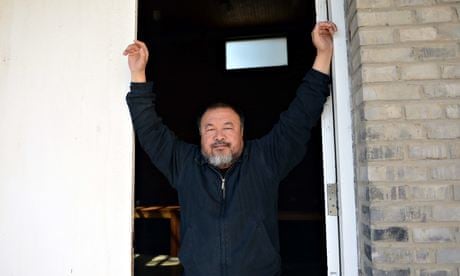China's legendary dissident artist Ai Weiwei is to make another foray into popular culture (following his heavy-metal record and dance video) as he appears in a forthcoming science-fiction film called The Sandstorm. It's set in a "dystopian Beijing", and filmed on location there, according to reports, so maybe his involvement has a political edge. And far from a Hollywood blockbuster, it is a short film funded by Kickstarter, so it's all very artistically pure.
However, this is not the first time a famous artist has made a cameo appearance in a film – and some have been far more surreal.
Here are some artists to look out for if you plan to spend this weekend watching films back to back and are in search of a vague thread of connection to justify your binge.
Jeff Koons appears as a slick San Franscisco politician called Art Agnos in the 2008 film Milk. He's seen in a black wig, arguing with Harvey Milk, played by Sean Penn. The film's director, Gus van Sant, said he saw Koons on TV and decided he was perfect for the role: "I thought he'd be good – he was such a good salesman."
So in some sense Koons is playing himself in Milk – the artist as salesman or smoothtalking political candidate. That makes his cameo not unlike the much earlier cinema scene when Marcel Duchamp and Man Ray also play themselves, playing chess, on a Paris rooftop in Rene Clair's Entr'acte. In fact, this 1924 silent classic probably features more cameos by great artists than any other film. In another sequence, Francis Picabia and the avant garde composer Erik Satie fire a cannon.
Another cameo role by a legendary modern artist is Max Ernst's appearance as a bandit leader in Luis Buñuel's 1930 film L'Age d'Or. In its 1929 companion piece Un Chien Andalou you can can see the young Salvador Dalí as a priest – a surreally inappropriate part for him in this masterpiece of surrealist cinema, which Dalí collaborated with Bunuel to create.
Reading on mobile? Click here to watch Un Chien Andalou
Some artists were born for cinema. It seems tragic now that Joseph Beuys, the most intense and original of postwar German artists and a haunting charismaric presence, did not branch out into feature films. He could surely have played a Nosferatu to rival Klaus Kinski's. But Beuys did actually make one foray into the German cinema of the 1970s: he appears in the aesthetically radical Beethoven biopic Ludwig Van.
In Victor Erice's film The Quince Tree Sun, the Spanish painter Antonio López Garcia plays himself: as he struggles to capture nature on canvas, art and cinema blur, and the search for cameos by artists becomes an encounter with pure art. This is also true of my favourite appearance by an artist on film, David Hockney's enigmatic performance as himself in Jack Hazan's A Bigger Splash. Is this a documentary, an art movie or a story in which the participants act out their own viewpoints? Whatever it is, it puts Hockney's intimate world on screen in a way that goes beyond star-spotting into something much more real – and too painfully real for Hockney, who has never shared his life so openly again.

Comments (…)
Sign in or create your Guardian account to join the discussion